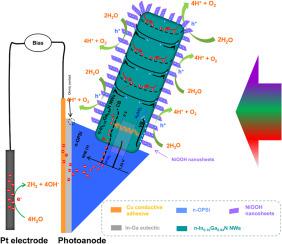Nano Energy ( IF 16.8 ) Pub Date : 2021-01-15 , DOI: 10.1016/j.nanoen.2021.105768 Hedong Chen , Peng Wang , Xingyu Wang , Xingfu Wang , Lujia Rao , Yinping Qian , Hongjie Yin , Xianhua Hou , Huapeng Ye , Guofu Zhou , Richard Nötzel

|
We study Ⅲ-nitride nanowire (NW) anti-reflection structures employed as photoelectrocatalyst for solar water splitting. We found that 1D vertical InGaN NW arrays tilted by 73° exhibit maximized photocurrent. Therefore, we grow 3D InGaN NW arrays on the facets of oblique pyramid-textured Si (311) (OPSi/InGaN) by plasma-assisted molecular beam epitaxy, exhibiting facets tilted by 73°. In addition, using finite difference time domain simulations we find the crucial impact of the asymmetry of the oblique pyramid InGaN NW arrays on the light trapping. Compared with InGaN NWs grown on a planar Si substrate (Si/InGaN), the OPSi/InGaN photoanode exhibits ~500% enhancement of the photocurrent due to various light trapping effects attributed to: 1D vertical NW arrays, their tilt, 3D arrangement and asymmetry. Decorated with NiOOH co-catalyst, the OPSi/InGaN photoanode exhibits photocurrent densities in the mA cm−2 range. The present research provides a rational design for the fabrication of nanostructured photoelectrocatalyst with enhanced light absorption.
中文翻译:

斜金字塔质感Si(311)上的3D InGaN纳米线阵列,用于光捕获和太阳能水分解增强
我们研究了Ⅲ型氮化物纳米线(NW)的抗反射结构,该结构用作光电子催化剂用于太阳能水的分解。我们发现倾斜了73°的一维垂直InGaN NW阵列显示出最大的光电流。因此,我们通过等离子辅助分子束外延在倾斜的金字塔质构Si(311)(OPSi / InGaN)的刻面上生长3D InGaN NW阵列,其刻面倾斜了73° 。此外,使用时域有限差分仿真,我们发现了斜金字塔InGaN NW阵列的不对称性对光阱的关键影响。与在平面Si衬底(Si / InGaN)上生长的InGaN NW相比,由于各种光捕获效应,OPSi / InGaN光电阳极显示出约500%的光电流增强,归因于:1D垂直NW阵列,其倾斜,3D排列和不对称性。用NiOOH助催化剂装饰后,OPSi / InGaN光阳极显示出mA cm -2范围内的光电流密度。本研究为光吸收增强的纳米结构光催化剂的制备提供了合理的设计。











































 京公网安备 11010802027423号
京公网安备 11010802027423号